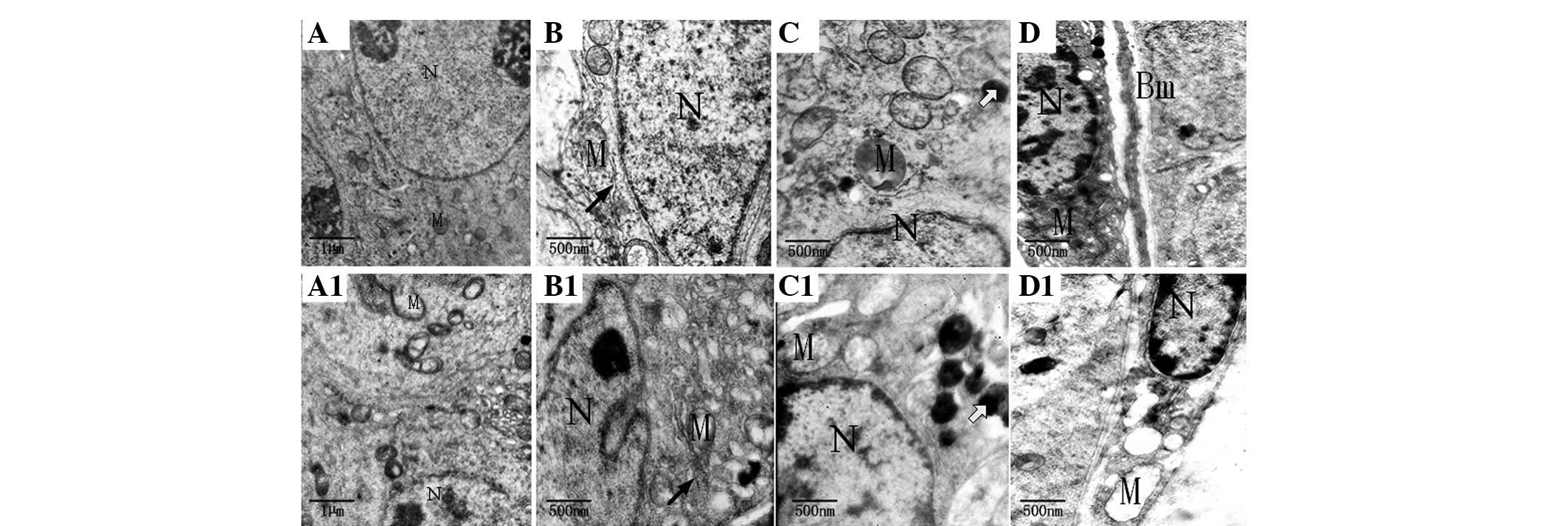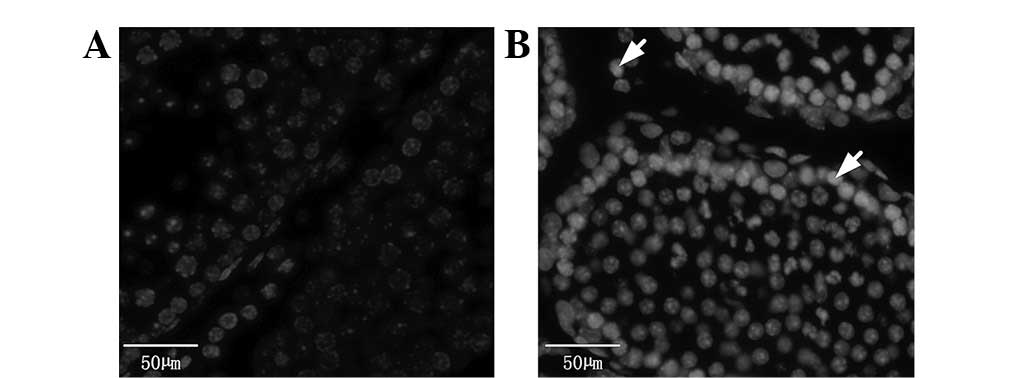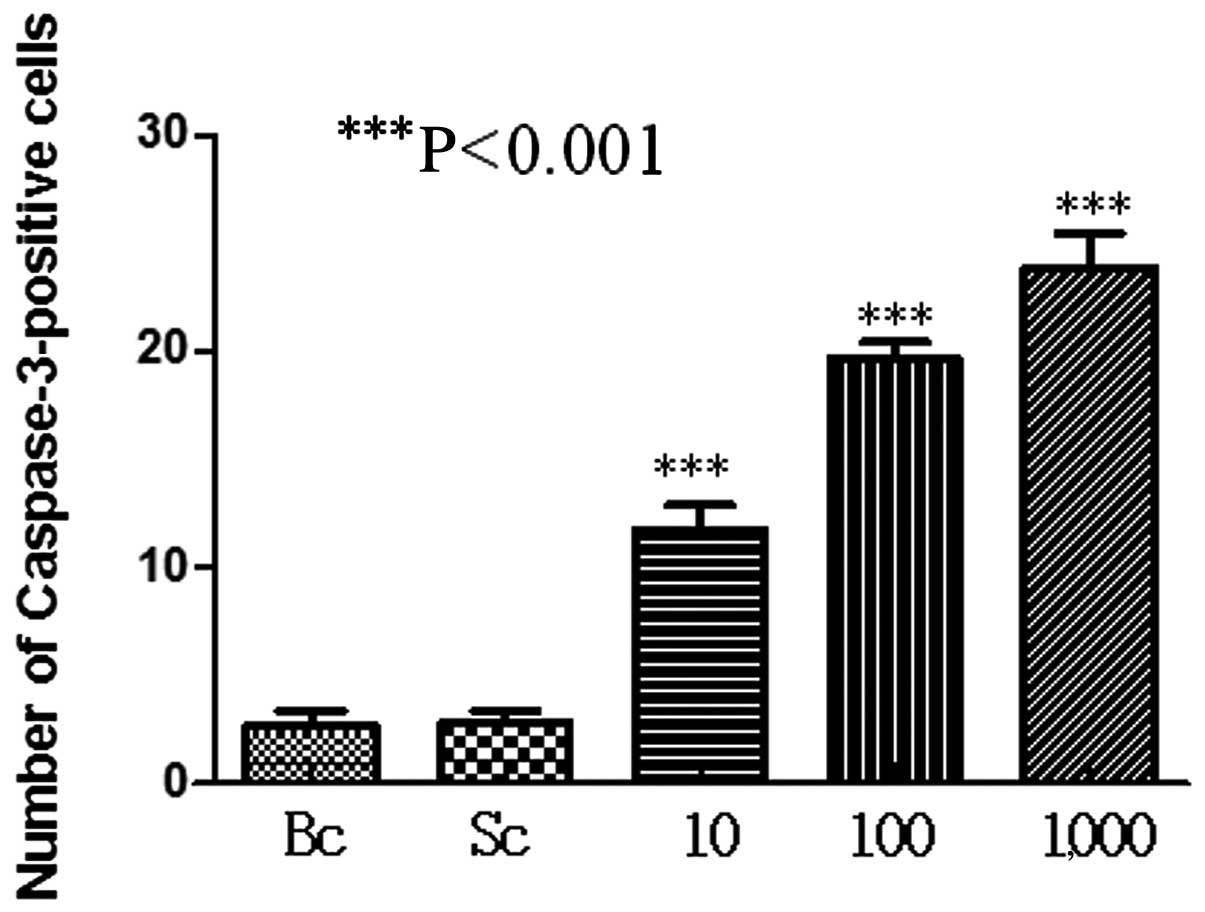|
1
|
Richter CA, Birnbaum LS, Farabollini F, et
al: In vivo effects of bisphenol A in laboratory rodent studies.
Reprod Toxicol. 24:199–224. 2007. View Article : Google Scholar : PubMed/NCBI
|
|
2
|
Le HH, Carlson EM, Chua JP, et al:
Bisphenol A is released from polycarbonate drinking bottles and
mimics the neurotoxic actions of estrogen in developing cerebellar
neurons. Toxicol Lett. 176:149–156. 2008. View Article : Google Scholar : PubMed/NCBI
|
|
3
|
Takahashi A, Higashino F, Aoyagi M, et al:
Bisphenol A from dental polycarbonate crown upregulates the
expression of hTERT. J Biomed Mater Res B Appl Biomater.
71:214–221. 2004. View Article : Google Scholar : PubMed/NCBI
|
|
4
|
Besaratinia A and Pfeifer GP: A review of
mechanisms of acrylamide carcinogenicity. Carcinogenesis.
28:519–528. 2007. View Article : Google Scholar : PubMed/NCBI
|
|
5
|
World Health Organization: FAO/WHO
Consultation on the Health Implications of Acrylamide in
Food-Summary Report. Geneva, Switzerland: WHO; pp. 1–12. 2002
|
|
6
|
Stadler RH, Blank I, Varga N, et al:
Acrylamide from Maillard reaction products. Nature. 419:449–450.
2002. View
Article : Google Scholar : PubMed/NCBI
|
|
7
|
Braniste V, Jouault A, Gaultier E, et al:
Impact of oral bisphenol A at reference doses on intestinal barrier
function and sex differences after perinatal exposure in rats. Proc
Natl Acad Sci USA. 107:448–453. 2010. View Article : Google Scholar : PubMed/NCBI
|
|
8
|
Hideaki K, Amakawa M and Shishibori T:
Exposure to bisphenol A during embryonic/fetal life and infancy
increases oxidative injury and causes underdevelopment of the brain
and testis in mice. Life Sci. 74:2931–2940. 2004. View Article : Google Scholar : PubMed/NCBI
|
|
9
|
Horstman KA, Naciff JM and Overmann GJ:
Effects of transplacental 17-α-ethynyl estradiol or bisphenol A on
the developmental profile of steroidogenic acute regulatory protein
in the rat testis. Birth Defects Res B Dev Reprod Toxicol.
95:318–325. 2012.
|
|
10
|
Takahashi O and Oishi S: Testicular
toxicity of dietarily or parenterally administered biaphenol A in
rats and mice. Food Chem Toxicol. 41:1035–1044. 2003. View Article : Google Scholar : PubMed/NCBI
|
|
11
|
Thuillier R, Manku G, Wang Y and Culty M:
Changes in MAPK pathway in neonatal and adult testis following
fetal estrogen exposure and effects on rat testicular cells.
Microsc Res Tech. 72:773–786. 2009. View Article : Google Scholar : PubMed/NCBI
|
|
12
|
Ema M, Fujii S, Furukawa M, et al: Rat
two-generation reproductive toxiccity study of bisphenol A. Reprod
Toxicol. 15:505–523. 2001. View Article : Google Scholar : PubMed/NCBI
|
|
13
|
Kato H, Furuhashi T, Tanaka M, et al:
Effects of bisphenol A given neonatally on reproductive functions
of male rats. Reprod Toxicol. 22:20–29. 2006. View Article : Google Scholar : PubMed/NCBI
|
|
14
|
Yan HH and Cheng CY: Blood-testis barrier
dynamics are regulated by an engagement/disengagement mechanism
between tight and adherens junctions via peripheral adaptors. Proc
Natl Acad Sci USA. 102:11722–11727. 2005. View Article : Google Scholar
|
|
15
|
Toyama Y, Suzuki-Toyota F, Maekawa M, et
al: Adverse effects of bisphenol A to spermiogenesis in mice and
rats. Arch Histol Cytol. 67:373–381. 2004. View Article : Google Scholar : PubMed/NCBI
|
|
16
|
Hermo L, Pelletier RM, Cyr DG and Smith
CE: Surfing the wave, cycle, life history, and genes/proteins
expressed by testicular germ cells. Part1: background to
spermatogenesis, spermatogonia, and spermatocytes. Microsc Res
Tech. 73:241–278. 2010. View Article : Google Scholar : PubMed/NCBI
|
|
17
|
Minamiyama Y, Ichikawa H, Takemura S, et
al: Generation of reactive oxygen species in sperms of rats as an
earlier marker for evaluating the toxicity of endocrine-disrupting
chemicals. Free Radic Res. 44:1398–1406. 2010. View Article : Google Scholar : PubMed/NCBI
|
|
18
|
de Rooij DG and Russell LD: All you wanted
to know about spermatogonia but were afraid to ask. J Androl.
21:776–798. 2000.PubMed/NCBI
|
|
19
|
Oatley JM and Brinster RL: Regulation of
spermatogonial stem cell self-renewal in mammals. Annu Rev Cell Dev
Biol. 24:263–286. 2008. View Article : Google Scholar : PubMed/NCBI
|
|
20
|
Tripathi R, Mishra DP and Shaha C: Male
germ cell development: turning on the apoptotic pathways. Reprod
Immunol. 83:31–35. 2009. View Article : Google Scholar : PubMed/NCBI
|
|
21
|
Fiorini C, Tilloy-Ellul A, Chevalier S, et
al: Sertoli cell junctional proteins as early targets for different
classes of reproductive toxicants. Reprod Toxicol. 18:413–421.
2004. View Article : Google Scholar : PubMed/NCBI
|
|
22
|
Sharpe RM, Mckinnell C, Kivlin C and
Fisher JS: Proliferation and functional maturation of Sertoli
cells, and their relevance to disorders of testis function in
adulthood. Reproduction. 125:769–784. 2003. View Article : Google Scholar
|
|
23
|
Yan HH, Mruk DD and Cheng CY: Junction
restructuring and spermatogenesis: the biology, regulation, and
implication in male contraceptive development. Curr Top Dev Biol.
80:57–92. 2008. View Article : Google Scholar : PubMed/NCBI
|
|
24
|
Mruk DD and Cheng CY: Sertoli-Sertoli and
Sertoli-germ cell interactions and their significance in germ cell
movement in the seminiferous epithelium during spermatogenesis.
Endocr Rev. 25:747–806. 2004. View Article : Google Scholar : PubMed/NCBI
|
|
25
|
Yeh S, Tsai MY, Xu Q, et al: Generation
and characterization of androgen receptor knockout (ARKO) mice: an
in vivo model for the study of androgen functions in selective
tissues. Proc Natl Acad Sci USA. 99:13498–13503. 2002. View Article : Google Scholar : PubMed/NCBI
|
|
26
|
Romano F, Tripiciano A, Muciaccia B, et
al: The contractile phenotype of peritubular smooth muscle cells is
locally controlled: possible implications in male fertility.
Contraception. 72:294–297. 2005. View Article : Google Scholar : PubMed/NCBI
|
|
27
|
Fadeel B, Ottosson A and Pervaiz S: Big
wheel keeps on turning: apoptosome regulation and its role in
chemoresistance. Cell Death Differ. 15:443–452. 2008. View Article : Google Scholar : PubMed/NCBI
|
|
28
|
Youle RJ and Strasser A: The BCL-2 protein
family: opposing activities that mediate cell death. Nat Rev Mol
Cell Biol. 9:47–59. 2008. View
Article : Google Scholar : PubMed/NCBI
|
|
29
|
Porter AG and Jänicke RU: Emerging roles
of caspase-3 in apoptosis. Cell Death Differ. 6:99–104. 1999.
View Article : Google Scholar : PubMed/NCBI
|



















